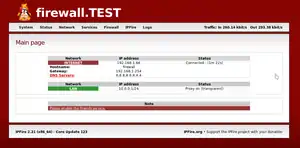 Web interface | |
| Developer | IPFire-Team |
|---|---|
| Source model | Open source (free software) |
| Latest release | Version 2.27 Core Update 175[1] / June 12, 2023 |
| Available in | Multilingual (including English) |
| Package manager | Pakfire |
| Platforms | x86-64, i686, i586, ARM |
| Kernel type | Linux kernel[2] |
| Official website | www |
IPFire is a hardened[3] open source Linux distribution that primarily performs as a router and a firewall; a standalone firewall system with a web-based management console for configuration.
IPFire originally started as a fork of IPCop[4] and has been rewritten on basis of Linux From Scratch since version 2.[5] It supports installation of add-ons to add server services, which can be extended into a SOHO server.[6] In April 2015, the project became a member of the Open Invention Network.[7]
System Requirements
The basic requirements are at least a 1 GHz CPU, 1GB of RAM, and a 4GB hard drive. Two network cards are needed to connect to an Ethernet network. DSL, LTE and Wi-Fi (WLAN) are supported, too, with corresponding hardware.[8]
The required computing power to run IPFire depends on the area of application. Most commonly, x86 systems are being used, but ARM devices, such as Raspberry Pi or Banana Pi, are supported, too.[9] IPFire can be used in virtual environments (such as KVM, VMWare, XEN, Qemu, etc.).
The basic setup of IPFire happens over a guided dialogue on the console, and the further administration takes place on the web-based management interface, such as add-ons and additional features.[10]
System Details
The project is regularly updated by the development team to maintain the security.[11] Developed as a stateful packet inspection (SPI) firewall.[12]
IPFire separates the network into different segments based on their security risk which are organised in colours. Normal clients connected to the LAN are represented as green, the Internet is represented as red, an optional DMZ is represented as orange and an optional Wireless network is represented as blue. No traffic can flow between segments unless specifically permitted through a firewall rule.[13]
IPFire's package management system, called Pakfire[14] allows to install system updates, which keep security up to date, and additional software packages for customisation to different usage scenarios and needs. The Linux system is customised for the concrete purpose of a firewall.[15]
The design is modular, making its functionalities extensible through plugins,[16] but the base comes with the following features[17]
- Stateful packet-inspection firewall based on Linux Netfilter
- Proxy server with content filter and catching-updates functions (e.g. Microsoft Windows updates, virus scanners, etc.)
- Intrusion detection system (Snort) with the option to install the Intrusion Prevention System guardian via Pakfire
- Since Core Update 131 it features the intrusion prevention system "Suricata" instead of snort[18]
- Virtual private network (VPN) with IPsec and OpenVPN
- Dynamic Host Configuration Protocol (DHCP) server
- Caching name-server (supports DNSSEC[19])
- Time server
- Wake-on-LAN (WOL)
- Dynamic DNS
- Quality of service (QoS)
- System monitoring functions and log analysis
- GeoIP filtering[20]
- Captive Portal[21]
IPFire Location
The IPFire Project built a free Internet geolocation database published under the Creative Commons license.[22] It is being used by The Tor Project to identify the location of Tor nodes and relays.
See also
References
- ↑ "IPFire 2.27 - Core Update 175".
- ↑ Nestor, Marius (9 January 2018). "IPFire Open Source Firewall Linux Distro Gets Huge Number of Security Fixes". Softpedia. Retrieved 25 July 2018.
- ↑ rascal23 (9 November 2017). "Latest IPFire 2.19 Linux Firewall Update Patches OpenSSL, Wget Vulnerabilities". Full Circle. Full Circle. Retrieved 25 July 2018.
{{cite web}}: CS1 maint: numeric names: authors list (link) - ↑ "Home". ipcop.org.
- ↑ Vervloesem, Koen. "IPFire 2.5: Firewalls and more". LWN.net. Retrieved 25 July 2018.
- ↑ Shah, Palak (2017-03-03). "Top 10 effective and efficient open source firewalls - Open Source For You". Open Source For You. Retrieved 2018-08-02.
- ↑ "The OIN Community - Open Invention Network". Open Invention Network. Archived from the original on 2018-06-23. Retrieved 2018-06-22.
- ↑ "Build Your Own Mini-ITX Firewall with IPFire – Complete DIY Guide". Ricmedia PC Help. 2017-03-14. Retrieved 2018-06-22.
- ↑ "How to Install 'IPFire' Free Firewall Linux Distribution". www.tecmint.com. 2 February 2015. Retrieved 2018-06-22.
- ↑ "IPFire Installation Handbook". Retrieved 2018-07-25.
- ↑ DistroWatch. "DistroWatch.com: IPFire". distrowatch.com. Retrieved 2018-06-21.
- ↑ "8 Open Source Firewalls to Secure Your BUSINESS". PCQuest. 2016-03-10. Retrieved 2018-08-02.
- ↑ "Best free Linux firewalls of 2018". TechRadar. Retrieved 2018-06-21.
- ↑ "Pakfire - the IPFire Wiki".
- ↑ Ankerholz, Amber. "IPFire 2.11 " Linux Magazine". Linux Magazine. Retrieved 2018-06-21.
- ↑ "Download IPFire 2.19 Core 120 / 3.0 Alpha 1". softpedia. Retrieved 2018-07-26.
- ↑ "Review of IPFire: The Linux based home firewall and router distribution - Linux News Site". Linux News Site. 2017-07-08. Retrieved 2018-07-26.
- ↑ "wiki.ipfire.org - Intrusion Prevention System (IPS)". wiki.ipfire.org. Retrieved 2019-11-19.
- ↑ York, Dan (4 August 2014). "Deploy360 4 August 2014 IPFire Adds DNSSEC Validation In New Release Via Crowdfunding". Internet Society. Retrieved 25 July 2018.
- ↑ Nestor, Marius. "IPFire 2.17 Update 90 Gets GeoIP-Based Blocking, Legacy Microsoft Hyper-V Support". softpedia. Retrieved 2018-07-26.
- ↑ Nestor, Marius. "Latest IPFire 2.19 Linux Firewall Update Patches OpenSSL, Wget Vulnerabilities". softpedia. Retrieved 2018-07-26.
- ↑ "A new location database for the Internet". 7 August 2020. Retrieved 2021-12-17.